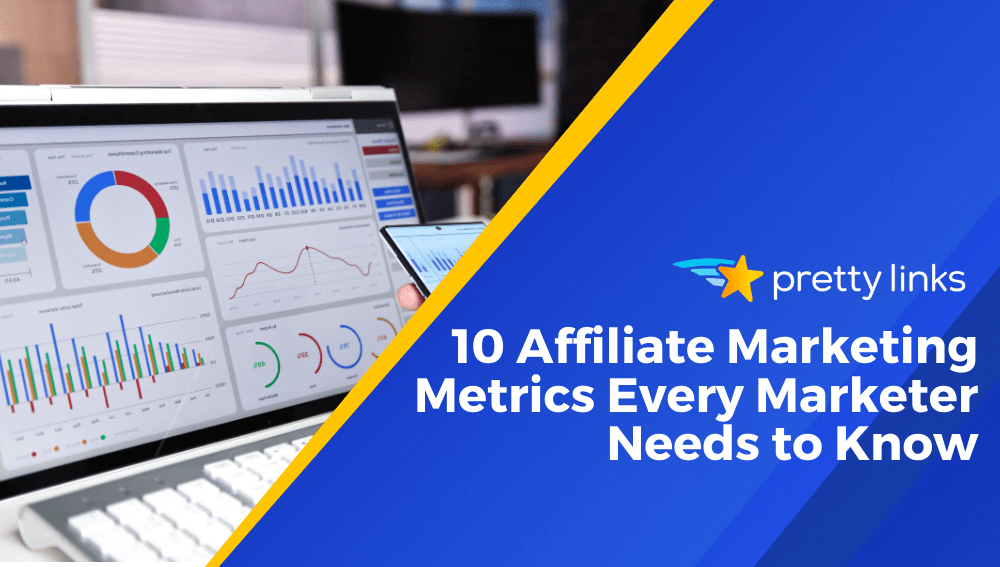Contents
Understanding the affiliate marketing metrics behind your campaigns is the difference between hoping for success and actively driving it.
These metrics aren’t just for data lovers – they’re vital insights for affiliate marketers who want to make informed, strategic decisions. By tracking these numbers, you’ll gain a clearer picture of where to focus your energy, optimize your budget, and maximize results.
In this blog, we’ll take a close look at 10 essential affiliate marketing metrics that every successful affiliate should be tracking. Whether you’re aiming to increase your commissions, optimize your marketing budget, or build long-term customer relationships, these numbers are the key to making it happen.
10 Critical Affiliate Marketing Metrics to Watch (+ How to Calculate and Track Results)
When it comes to building a successful affiliate marketing strategy, numbers don’t lie. Metrics offer you clear, actionable insights into what’s working and what’s not.
Instead of guessing why certain campaigns fall short, tracking the right data allows you to make adjustments that can improve your performance.
Let’s take a look at 10 critical affiliate marketing metrics, learn how to calculate them, and see how they can help you make more strategic, data-driven decisions for your campaigns.
1. Click-Through Rate (CTR)
Click-through rate (CTR) tells you how many people clicked on your affiliate link compared to how many people saw it. Think of it as your content’s “click appeal.”
How to Calculate: To calculate your click-through rate, simply divide the number of clicks by the number of times the content is shown (impressions), then multiplying by 100 to get a percentage. For example, if a banner ad is shown 2,500 times and gets 50 clicks, the CTR is 2%.
Why It Matters: A strong CTR shows that your affiliate links are effectively capturing attention and motivating users to take the next step. This is important because a high CTR usually leads to increased traffic and more opportunities for conversions. A low CTR, on the other hand, suggests your content isn’t engaging enough or that your links aren’t placed in optimal spots to attract clicks.
PrettyLinks Quick Tips on How to Improve Your Click-Through Rate:
- Spice Up Your CTAs: Use clear, action-driven phrases like “Find Out More” or “Get Started Now” to motivate clicks and engagement.
- Show Off Stunning Visuals: Choose high-quality, eye-catching images that fit your content and grab attention right away.
- Optimize Your Keywords: Focus on the right keywords that align with what your audience is searching for to boost your visibility.
- Perfect Link Placement: Place your affiliate links in spots where they’ll be noticed, like after a strong point or within key content.
- Test and Tweak: Keep experimenting with different CTAs, visuals, and link placements to see what connects best with your audience.
2. Conversion Rate
Your conversion rate measures how many people take the action you want – like making a purchase, subscribing to a newsletter, or downloading a resource – after clicking a link. It’s a clear indicator of how well your offer is working.
How to Calculate: To find your conversion rate, you divide the number of successful conversions by the total number of people who clicked on the affiliate link. After that, multiply the result by 100 to turn it into a percentage. For example, if 500 people click on a link and 25 make a purchase, the conversion rate would be 5%.
Why It Matters: Your conversion rate is one of the most important affiliate marketing metrics because it directly measures how well your offers resonate with your audience. If your conversion rate is low, it could point to several issues, such as a disconnect between your audience’s needs and the offer or unclear messaging that doesn’t highlight the value effectively.
Improving your conversion rate can significantly boost your affiliate income by turning more clicks into actual sales or leads.
PrettyLinks Quick Tips on How to Increase Your Conversion Rate:
- Target the Right Traffic: Focus on attracting visitors who are most likely to engage, such as through niche-specific blogs or targeted email campaigns.
- Write Clear and Persuasive Content: Ensure your messaging speaks directly to your audience’s needs and clearly highlights the benefits of your offer.
- Build Trust: Use testimonials, reviews, or case studies to provide social proof and build confidence in your product.
3. Earnings Per Click (EPC)
Earnings per click (EPC) reveals how much revenue each click on your affiliate links generates, giving you a clear idea of your profitability.
This affiliate marketing metric is especially useful for affiliates running pay-per-click (PPC) ads, as it helps track profitability by comparing costs to earnings. A well-calculated EPC lets you determine whether the revenue generated from clicks outweighs the costs of ads.
How to Calculate: To find your EPC, divide your total commission earned by the number of clicks on your affiliate links. For example, if you earned $100 from 50 clicks, your EPC would be $2.
Why It Matters: EPC is essential because it measures how well your affiliate campaigns are performing financially. Tracking profitability through affiliate marketing metrics like EPC can help you determine whether the revenue generated from clicks outweighs the cost of your campaigns.
It helps you determine which products are most profitable, ensuring that you’re consistently earning more than you spend on ads, keeping your campaigns profitable over time.
PrettyLinks Quick Tips on How to Increase Your Earnings Per Click:
- Promote Higher Commission Products: Focus on products or services that offer better commissions, as higher payouts per sale will naturally increase your EPC.
- Diversify Product Types: Offer a range of products with varying price points, including higher-ticket items, to maximize the potential value from each click.
- Use Multi-Step Funnels: Direct clicks through a funnel where you offer additional value, like a free guide or email sign-up, before presenting the affiliate offer. This preps users, increasing the likelihood of a higher-value purchase.
- Incorporate Popups for Better Engagement: Affordable tools like PopupAlly allow you to create popups that capture attention and encourage more clicks, which can significantly boost your EPC.
4. Average Order Value (AOV)
Average order value (AOV) measures the average amount of money spent each time a customer buys a product through your affiliate link. It provides insight into how much your customers are spending per order.
How to Calculate: To calculate your customers’ AOV, divide the total revenue by the number of orders. For example, if your affiliate links generated $500 from 20 orders, your AOV would be $25.
Why It Matters: AOV is important because it allows you to maximize your earnings per conversion without needing to drive additional traffic. When traffic is slow, focusing on boosting AOV can help you maintain or increase revenue by getting more value out of each purchase.
By encouraging customers to spend more per order, you can drive higher commissions and maximize the profitability of each sale.
PrettyLinks Quick Tips on How to Improve Your Average Order Value:
- Encourage Upsells: Recommend higher-priced or upgraded versions of the products your customers are viewing. For example, if a customer is looking at a basic version, suggest a premium option with extra features.
- Implement Cross-Selling: Suggest related or complementary products that pair well with the customer’s purchase. For example, if they are buying a camera, offer accessories like a memory card or a protective case.
- Create Bundled Recommendations: Instead of promoting one product, offer a bundle of complementary products. The higher overall purchase value from a bundle increases your AOV when multiple items are purchased.
- Use Enhanced Tracking: Utilize tools like Google Analytics with enhanced ecommerce tracking to monitor transaction values and orders, allowing you to track your AOV over time and identify areas for improvement.
5. Lifetime Value (LTV)
Lifetime value (LTV) measures the total revenue a customer will generate throughout their relationship with a brand. It considers all factors that contribute to long-term profitability, such as repeat purchases and subscription renewals.
How to Calculate: To monitor LTV, use tools like Google Analytics with User-ID tracking to associate multiple transactions with individual users. Enhanced ecommerce tracking allows you to keep an eye on purchase data, repeat purchases, transaction history, customer retention, and total revenue over time per customer.
Why It Matters: Lifetime Value (LTV) is an often-overlooked affiliate marketing metric that gives you insights into how much revenue a customer will generate over time. High LTV means your customers are sticking around, making repeat purchases, and engaging with your affiliate links, boosting your commissions over time.
PrettyLinks Quick Tips on How to Improve Your Lifetime Value:
- Partner with Preferred Brands: Build partnerships with brands your audience already knows and loves, allowing you to promote products that resonate with them and increase the likelihood of repeat purchases.
- Promote Recurring Products: Select items like subscriptions or consumables that naturally encourage repeat purchases, keeping customers coming back.
- Offer Exclusive Deals: Reward loyal customers with special discounts or exclusive content access to encourage them to return and shop again through your affiliate links.
- Build Strong Relationships: Engage regularly with your audience to foster trust and loyalty, ensuring they turn to your recommendations for future purchases.
6. Return on Investment (ROI)
Return on investment (ROI) measures the overall profitability of your affiliate marketing campaigns in relation to what you spend. It shows how effectively your marketing dollars are turning into profit and helps evaluate the value of your efforts.
How to Calculate: To calculate ROI, subtract your campaign cost from your revenue to get the net profit. Then, divide that profit by the campaign cost and multiply by 100 to get a percentage. For example, if you spend $500 and earn $1,500, your net profit is $1,000. Divide that by $500 and multiply by 100, giving you an ROI of 200%.
Why It Matters: ROI offers a big-picture view of whether your affiliate marketing is profitable. A high ROI shows that your efforts are delivering strong financial returns, while a low ROI suggests that you may need to adjust your strategy by either reducing costs or improving your conversion process.
Unlike Earnings Per Click (EPC), ROI focuses on the overall profitability of the campaign. While EPC is great for optimizing individual link performance, ROI tells you if your overall affiliate marketing efforts are worth the investment.
PrettyLinks Quick Tips on How to Improve Your Return on Investment:
- Trim Low-Performing Campaigns: Eliminate campaigns that don’t convert and reallocate the budget to those with proven success to boost ROI.
- Increase Average Order Value: Promote bundled products or upsells to raise the value of each transaction, enhancing your return without additional spend.
- Use Retargeting Ads: Focus retargeting on users who’ve already shown interest, as they are more likely to convert, which reduces your cost per acquisition and increases ROI.
- Automate Any and All Tasks: Automate repetitive tasks to free up your time and ensure efficient, consistent results without adding extra costs. Automation reduces manual effort and helps you maximize returns by keeping your campaigns running smoothly with minimal oversight.
7. Impressions
Impressions track how often your affiliate links, ads, or banners are shown to users across various platforms, such as websites, search engines, or social media. Impressions measure visibility, showing how often your content appears on someone’s screen, even if they don’t engage with it.
How to Track: Many analytics tools track impressions automatically. These platforms provide data on how many times your ads or links are displayed to users, allowing you to measure your content’s reach over time. Some tools even offer breakdowns by demographics, geography, and platform to give you deeper insights into where your impressions are coming from.
Why It Matters: While impressions don’t reflect direct engagement, they are a key indicator of how many people are being exposed to your affiliate links or promotions. High impressions mean that your content is visible and reaching a broader audience. However, low impressions may signal that your content isn’t reaching enough people or isn’t showing up in the right places.
By optimizing for impressions, you increase your potential to drive traffic to your affiliate offers and boost conversions down the line.
PrettyLinks Quick Tips on How to Increase Your Impressions:
- Tailor Ads to Your Audience: Ensure your ads are targeted to the correct audience by using demographic filters like age, interests, and location. The more relevant your content is to viewers, the more likely they are to engage with it, leading to higher impressions as platforms favor relevant ads.
- Experiment with Ad Placement: Test your ad placements across different platforms (like social media, blogs, or search engines) and within different sections of a website to maximize visibility. Some spots, such as above-the-fold sections or pop-ups, may generate higher impressions than ads buried further down a page.
- Leverage Different Formats: Use a variety of ad formats like video, carousel ads, or interactive banners to keep your content fresh and engaging. Different formats work better on different platforms, so mixing things up can help increase your total impressions across the board.
- Collaborate with Influencers or Bloggers: Partnering with influencers or bloggers who align with your brand can expose your affiliate links to a wider audience. Their endorsements or mentions in their content can amplify your impressions, leading to greater visibility and potential engagement.
- Optimize Timing: Publish your ads or banners at times when your audience is most active. This will increase the likelihood that more people will see your content.
8. Bounce Rate
Bounce rate measures the percentage of visitors who land on your webpage and leave without interacting or taking any further action, such as clicking links or filling out a form. This affiliate marketing metric helps you understand if visitors are finding what they’re looking for on your site.
How to Track: Bounce rate is an affiliate marketing metrics that shows the percentage of visitors who leave your website after viewing only one page. Most analytics tools, like Google Analytics, automatically track bounce rates. It’s calculated by the number of single-page visits by the total number of visits and multiplied by 100. For instance, if 1,000 people visit your site in a day and 300 of them leave after just one page, the bounce rate would be 30%.
Why It Matters: A high bounce rate is a red flag that your landing pages might not be engaging enough to keep visitors interested. This can happen for several reasons, such as irrelevant content, poor user experience, slow loading times, or an unattractive design.
A high bounce rate can negatively impact your conversion rates, SEO rankings, and overall customer satisfaction.
PrettyLinks Quick Tips on How to Improve Your Bounce Rate:
- Create a User-Friendly Design: A clean, visually appealing page design that’s easy to navigate helps keep visitors on your site longer, reducing bounce rates.
- Use Targeted CTAs: Guide visitors with clear calls to action that match the context of the page and the visitor’s intent, making it easy for them to take the next step.
- Optimize for Mobile: Make sure your site is responsive and offers a seamless experience for mobile users, as many visitors access websites on their phones.
- Improve Load Speed: A slow-loading page frustrates users, leading to higher bounce rates. Tools like WP Rocket or Cloudflare can help optimize site speed.
9. Chargeback Fee
A chargeback fee, also referred to as a reversal rate, represents the percentage of transactions where customers request a refund after making a purchase. This often occurs due to product dissatisfaction, issues with delivery, or a misunderstanding of the product’s features.
How to Calculate: Chargebacks can’t really be “calculated”. Instead, when a chargeback happens, your earned commission for that sale is taken back. So, if you made a commission on a sale and the customer requests a refund, that commission is removed from your earnings.
Why It Matters: High chargeback rates have a direct financial impact, as they reduce your overall earnings. Beyond the immediate loss of commission, frequent chargebacks can damage your reputation as an affiliate. Brands may see a high reversal rate as a sign that you’re promoting products irresponsibly or to the wrong audience, which could lead to your account being suspended or your affiliate relationship being terminated.
Maintaining a low chargeback rate is essential for building long-term trust with brands and maintaining steady earnings.
PrettyLinks Quick Tips on How to Reduce Your Chargeback Fee:
- Promote High-Quality Products: Always choose products that have strong reputations, positive customer reviews, and reliable return policies. Products with a proven track record of satisfaction are less likely to result in chargebacks.
- Accurate and Honest Product Descriptions: Ensure that your product descriptions are clear, accurate, and align with the actual features of the product. Avoid overstating benefits or making claims that the product cannot fulfill.
- Follow-Up with Customers Post-Purchase: Consider sending a follow-up email or message to check in with customers after they make a purchase. This can be an opportunity to offer support, answer questions, or resolve minor issues before they escalate into refund requests.
- Set Clear Expectations: Make sure customers understand delivery times, return policies, and any conditions that may affect their purchase. By managing expectations upfront, you can prevent misunderstandings that often lead to chargebacks.
- Monitor Chargeback Trends: Keep track of chargebacks to identify any patterns. If certain products or promotions are resulting in higher-than-usual chargebacks, you can adjust your strategy accordingly.
10. Traffic Sources
Traffic sources refer to the origins of visitors coming to your affiliate site, whether through paid ads, organic search, social media platforms, email campaigns, or referral links from other websites. Each source provides insight into how your audience discovers your content and interacts with it, giving you essential data to refine your marketing efforts.
How to Track: Use tools like Google Analytics to categorize traffic into specific channels, such as organic search, referral (other websites linking to you), direct (users typing in your URL), and paid (Google Ads, Facebook Ads). Analyze which sources drive the most conversions and engagement, not just visits.
Why It Matters: Tracking traffic sources gives you insights into which channels drive the most valuable visitors, so you can invest your time and budget effectively. For example, if you know which sources are bringing in the most visitors, you can:
- Maximize Your ROI: If organic search brings in the highest-quality traffic but paid ads are underperforming, you can adjust your budget and efforts to focus on the most profitable sources.
- Prevent Over-Reliance on One Channel: Relying too heavily on one source of traffic, like social media or paid ads, can be risky. If that source suddenly dips (due to algorithm changes or ad fatigue), your traffic and conversions could take a hit. Diversifying ensures a steady flow of visitors.
- Target Your Audience More Effectively: Knowing which traffic sources lead to the most engagement helps you tailor your content to match that audience’s needs and behaviors, increasing the likelihood of conversion.
PrettyLinks Quick Tips on How to Improve Your Traffic Sources:
- Double Down on Top-Performing Channels: Identify which traffic sources are driving the highest conversions. Once you’ve found these, allocate more resources to those sources and experiment with scaling them. For example, if organic traffic from SEO is performing well, consider investing in more content creation and SEO efforts.
- Diversify Your Traffic Mix: Never put all your eggs in one basket. If you’re getting most of your traffic from organic search, explore additional channels like email marketing, social media ads, or influencer partnerships to broaden your reach and reduce risk. A healthy mix of traffic sources provides a safety net against sudden changes in any single channel.
- Leverage Referral Traffic: Encourage partnerships with other bloggers, influencers, or complementary businesses to generate referral traffic. These visitors often have higher trust and engagement levels since they’re coming from trusted sources. Promote guest posts, link exchanges, or co-branded campaigns to drive more quality traffic.
- Analyze Traffic Engagement: Not all traffic is created equal. Use analytics tools to dive deeper into how each source of traffic engages with your site. High bounce rates or low session times from certain sources may indicate a misalignment in targeting or a need for better landing page optimization. Focus on the channels that bring engaged, long-term visitors.
What Affiliate Marketing Metrics Can You Track with PrettyLinks?
The PrettyLinks WordPress plugin is an invaluable tool for affiliate marketers. It not only shortens and cloaks long affiliate URLs, it also offers robust tracking and link management tools that provide deep insights into your marketing efforts.
Favorite PrettyLinks Link Tracking Features:
- Clicks: PrettyLinks tracks every click on your shortened URLs. This includes the total number of clicks, unique clicks, and the timestamps of these clicks.
- Conversion Tracking: With PrettyLinks, you can track conversions directly. This feature allows you to see how many clicks lead to actual purchases, sign-ups, or other desired actions, giving you a clear picture of your conversion rates.
- Geolocation Data: The plugin provides geolocation information on your link clicks, helping you understand where your audience is located. This data is crucial for tailoring your campaigns to specific regions or countries.
- Browser and Device Information: PrettyLinks logs the browsers and devices used by your visitors. This helps you optimize the user experience based on the most popular platforms and devices accessing your links.
- Link Health: PrettyLinks continuously monitors the health of your links, alerting you if any links become broken or lead to errors. Keeping your links healthy ensures a smooth user experience and maintains your professional credibility.
PrettyLinks provides a user-friendly dashboard that displays all this data in an easy-to-understand format. With its advanced tracking capabilities, PrettyLinks enables you to make data-driven decisions, optimize your marketing strategies, and ultimately increase your affiliate marketing revenue.
Conclusion
To wrap things up, understanding these affiliate marketing metrics is essential for making informed decisions that lead to better results. From click-through rates to conversions, these metrics offer clear insights into what’s working and where adjustments are needed to improve performance.
However, tracking these metrics efficiently requires the right tools. That’s where PrettyLinks comes in.
With its advanced tracking and management features, you’ll have access to critical data like clicks, conversions, and traffic sources, all in one place. This allows you to refine your strategies and focus on what drives success and ditch what doesn’t.
If you’re looking to simplify your tracking process and make more data-driven decisions, PrettyLinks is the tool you need. Start using it today to manage your affiliate links with ease and gain deeper insights into your campaigns.
If you could only monitor one affiliate marketing metric for the next month, which one would you choose and why? Let us know in the comments!








Leave a Reply